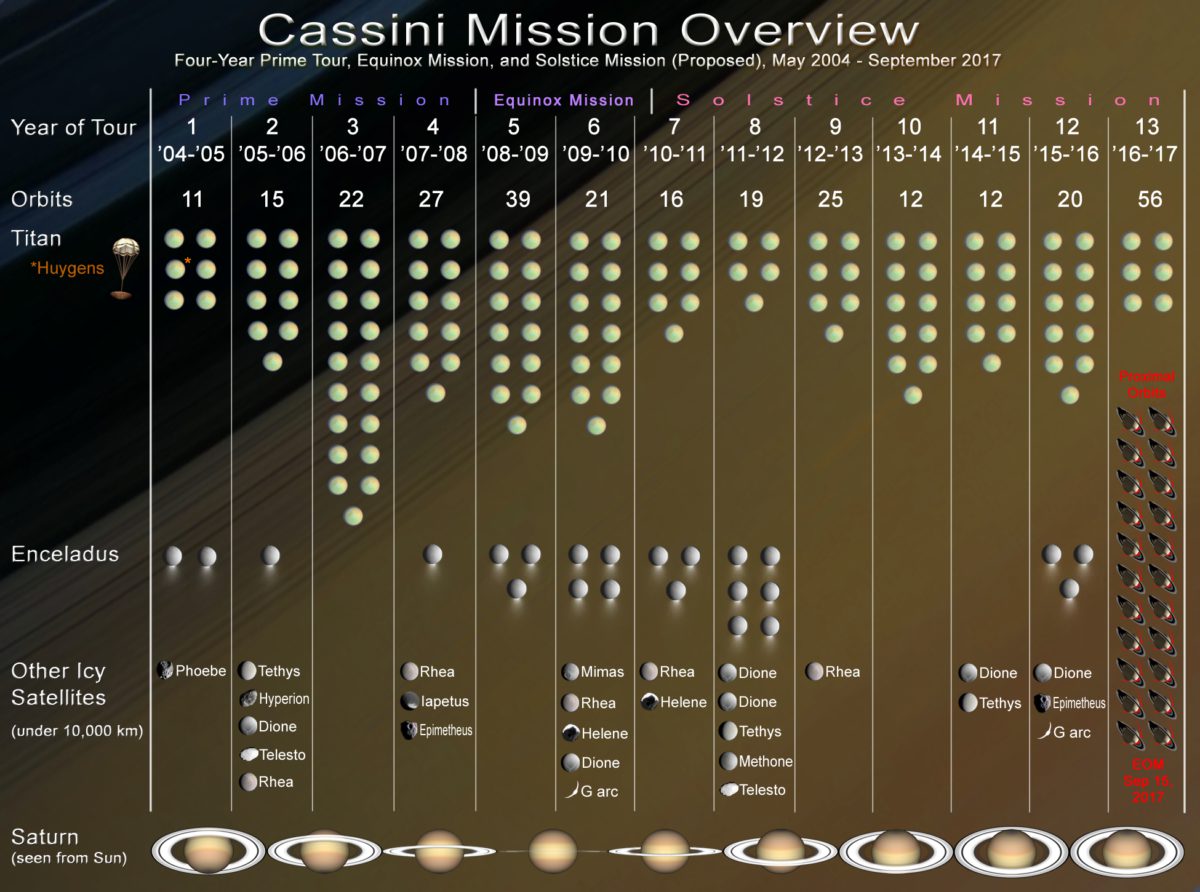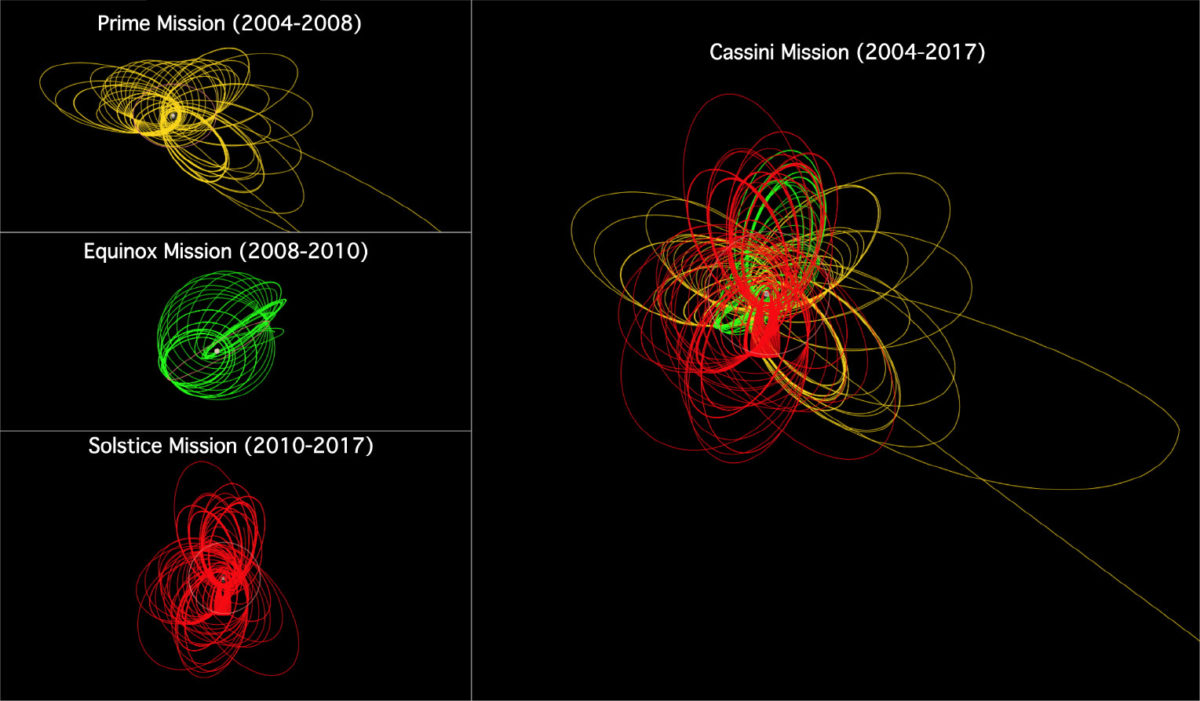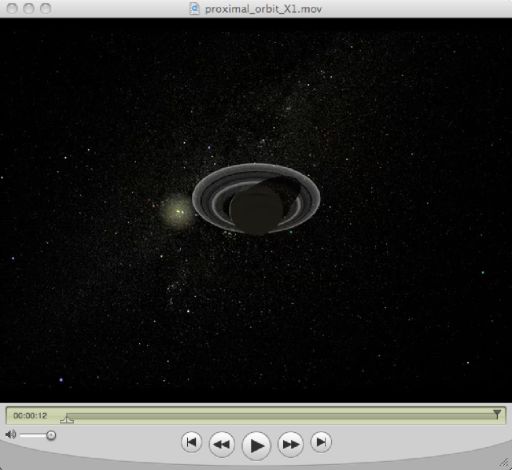John Smith • Jun 07, 2009
Designing the Cassini Tour
Quality is never an accident; it is always the result of high intention, sincere effort, intelligent direction and skillful execution; it represents the wise choice of many alternatives. [William A. Foster]
The Cassini spacecraft thus far has completed 112 orbits about Saturn, 56 close flybys of massive Titan, and 20 close flybys of the major Saturnian moons (such as the geyser-spouting Enceladus), from a wide variety of distances and orientations. Hopefully, much more science is yet to come should the proposed Solstice mission extension, which takes Cassini all the way to 2017, be approved by NASA.

Titan's gravitational tug on the spacecraft is Cassini's sole means of altering course and each Titan flyby provides an opportunity to go down many different paths. Each Titan flyby is not a fork in the road, but rather a Los Angeles style cloverleaf in terms of the dizzying number of possible destinations. Each flyby choice affects all downstream choices. So how did our current and future plans for the path of the Cassini spacecraft come to be? That's the question Dave Seal put to me since that's my job -- I am a tour designer.
Any tour of an interesting destination needs a tour guide to plan where to go, what to do, and when to do it (not to mention how to do it). The tour guide for human outings has to factor how many are going, the group's budget, and the duration of the trip. Success is measured by the level of satisfaction of all passengers once the trip is over. The path the Cassini spacecraft takes in orbit about Saturn is aptly referred to as the Cassini tour. JPL engineers, such as Brent Buffington and myself, design this tour.
Our tour bus is the Cassini spacecraft (whose dimensions are actually similar to a small school bus) loaded with instruments. Said instruments act much like virtual passengers for the more than 200 scientists working on the mission. Imagine driving a school bus of children all the way from Alaska to Disney World and that you are the lucky adult in charge of planning the group's itinerary during it's one and only day there. An added constraint is that all the kids must stay together as a group (after all, the instruments onboard the spacecraft can't go their separate ways either). The tour designer attempts to make all these kids equally happy at the end of their visit with the Mouse. A low stress job for sure!
I've had the unique privilege of being a tour designer for all portions of the Cassini trajectory from Saturn arrival in July 2004 through the just finished proposal for a mission extension that culminates with a spectacular series of orbits inside Saturn's rings followed by a suicide plunge into Saturn on Sept. 15, 2017. Cassini has had three episodes of tour design: the completed four-year prime mission, the two-year Equinox extended mission underway, and a proposed seven-year Solstice extended, extended mission.

As many people have commented, when projected in 2-D, the trajectory does indeed look like it was created using the Spirograph toy I had as a child. In fact, last year a good friend bought me a complete vintage Spirograph set to "aid me in my work". The elliptical orbits in these images are also reminiscent of the petals of a flower, and so Cassini folk refer to them as "petal plots".
The near infinite number of possible tours creates both opportunities and difficulties. The hundreds of scientists, many of whom have devoted two decades of their careers to this mission, are passionate that their instrument get its desired observational geometry but these desires are often mutually incompatible. For example, RADAR observations of the surface of Titan can't be conducted at the same time as imaging in the visible wavelengths since the boresights of the two instruments are orthogonal to one another.
The operational/engineering side of the house also levies constraints on the tour such as encounter frequency (for the Solstice mission, the staffing budget limits flybys to once per month on average) and onboard consumables available such as the fuel remaining to navigate the spacecraft. A substantial challenge for the Solstice tour design was cutting fuel consumption by ~400% to keep the tanks from running dry before summer solstice and the end-of-mission finale in 2017. This constraint made obtaining icy moon encounters such as Enceladus much more difficult since trajectories encountering these moons tend to be fuel hogs. Design of a 7-year tour is not something that's going to automated any time soon!
As mentioned, gravitational attraction experienced during a close Titan flyby is the sole means of significantly altering the spacecraft trajectory. Since Titan acts as the gas pump for the Cassini spacecraft, it's required that every orbit eventually return to Titan; otherwise, the spacecraft will be stranded in the same orbit (about as smart as driving your car until it runs out gas in Baja). It's interesting to note that if Titan's mass was anything like that of Saturn's other 60 moons, no tour would be possible- the spacecraft would just traverse the same elliptical orbit, over and over again.
The rocket engines on the spacecraft are primarily used to ensure the spacecraft hits the planned Titan aim points dead-on (the impressive job performed by the Navigation team) and some fuel is allocated for trajectories to icy moons that are just minutely off-track from a ballistic return to Titan. In an animated movie of the proposed Solstice tour (created by Brent Buffington), each incremental change in the orbit is due to a Titan flyby.

The Cassini Solstice Mission (2010-2017) Trajectory
4 Titan flybys shape the spacecraft trajectory. The trajectory about Saturn seen from an a distant viewpoint (left), from above the north pole of Saturn, Sun towards the top of the page (upper right), and ground tracks illustrating potential surface coverage of Titan (lower right). Click to view the animation.
One of my pet peeves is that gravity assist is really a simple concept though it's often misrepresented in the media and in sci-fi (if I hear it called a gravitational slingshot one more time, I think I'll implode). The basic concept is that if a small body passes by a much more massive, moving body -- without hitting it mind you - the small body's path is going to be altered in a predictable way. For Cassini, if the spacecraft passes behind Titan, its speed is increased since Titan's gravitational attraction pulls it along in the direction of Titan's motion. Conversely, pass in front of Titan, and the spacecraft is slowed down. Pass over the north or south poles of Titan, and the inclination (tilt) and orientation of the spacecraft orbit plane are changed. A continuum of choices between these extremes exists -- you get the idea.
The process for designing a tour is iterative utilizing feedback from both the science and engineering teams to prospective tour candidates created by the tour designers. Typically, 3 to 4 rounds of iteration occur each spaced about 4 to 7 months apart. I'll use the design of the Solstice mission as an example. To kick off round one, science objectives and corresponding observational geometries, as well as operational and engineering constraints, are delivered to the tour designers. Our job is then to design full 7-year mission trajectories that provide the observational geometries requested. Each round concludes at one of the weeklong science meetings that are held three times per year.
For example, Brent and I just finished polishing up the Solstice mission trajectory that attempted to satisfy (rather well we think) 24 priority-one and 18 priority-two science objectives. Some science objectives address seasonal change such as determining the temporal variability of Enceladus' geyser-like plumes (i.e., many close flybys under the south pole of Enceladus). Others address new questions such as understanding the methane/ethane lakes on Titan (i.e., many close flybys over Titan's polar regions for RADAR and other remote sensing), or whether there is ring material orbiting Rhea.
From my perspective, the more than 200 scientists working on Cassini are organized into five disciplines (Saturn, Titan, Icy Moons, Rings, and Magnetospheres and Plasma) much like a science senate with five member states. A separate executive branch is filled by a subset of these scientists. Despite pleading from the tour designers, a prioritization of science objectives from 1 to n has never happened since that would, in the words of the prior Project scientist, "leave blood on the floor". The best the tour designers get is a prioritized ranking within each of the five disciplines but often even this does not occur.
Tours are designed by first assuming an overall strategy that you think might satisfy the science desires and operational capabilities of the spacecraft and then through trial and error, after designing hundreds of snippets of tours, you begin to realize what might be done and how long each snippet is likely to take, etc. A general tour class is created which, by definition, can be summarized in layman's terms with just a few sentences. There can be many variations within a tour class but if you produce "petal plots" of the orbits, such tours will look similar.
In round one, the tour designers take the science desires and Project constraints, disappear from reality to create, play, and frustrate themselves. A shotgun approach is used to generate about half a dozen complete tours (each representative of a given tour class) that are as different as we can imagine while still satisfying a large number of science objectives. We use the shotgun approach since we tour designers are often surprised by which candidate tours rise to the top in the rankings. For the Equinox mission, none of the three tour designers (add in Nathan Strange) thought the class of tour preferred by the scientists (and underway at this moment) had much of a chance, and it was provided mostly for sake of completeness.
Engineering constraints must always be followed since spacecraft safety trumps science, but the tour designers push the envelope on these too. Round 1 ends with the weeklong science meeting and we hear from each science team and individuals what they liked and didn't like about each tour. To summarize, all 42 stated science objectives are colored green, yellow, or red to illustrate the degree of satisfaction with which each objective is met. My experience has been that the only way to get a feeling for the true prioritization of science goals is to release complete sample tours and get science team reaction to them. That's when we learn what people will really fight for, what isn't as important as we (and they) thought, and what's missing. The field of about six tour classes is narrowed down to two classes. Not surprisingly, sometimes the most useful data is garnered in a hallway conversation or over a beer at the end of the day.
In round two, another half dozen or so candidate tours are released which fit within the tour classes down-selected in round one. These tours tend to me much more finely crafted in certain respects such as the number and quality of icy moon flybys (which are incredibly time-consuming to find and implement). More feedback is obtained and a single class is selected for further development.
In round three, another half dozen tours all within the same tour class are released for evaluation. At the third weeklong science meeting, a final tour is selected. This week can be the most contentious one because this is pretty much the end of the road. Again, a green/yellow/red color-coded matrix is produced by the five discipline teams for all 42 science objectives and then heated discussion ensues as to which tour is the best overall tour. For the Solstice mission, the final tour was selected unanimously in the open session free for all to attend. However, for the Equinox mission, agreement in the main open session could not be reached, and so it was left to those scientists comprising the executive board (my version of the executive branch) to make the final selection. As I said earlier, the tour designer has done their job when they make everyone equally happy, or perhaps restated, equally unhappy.
For me, Cassini has provided a unique opportunity for an engineer to significantly impact the science return of a flagship mission to one, if not the most, target-rich destinations in the solar system. In my experience, such opportunities are exceedingly rare. Also, the caliber and passion of the people I've worked with (such as Brent and Dave) has been inspiring. In parting, the animation below presages the potentially great science to come. "Somewhere, something incredible is waiting to be known." [Carl Sagan]

Ride-Along View from One of the Proximal Orbits
A view of Saturn as seen by the spacecraft during one of the 19 orbits planned for late 2017 just prior to Saturn impact. The spacecraft passes inside the rings of Saturn just skimming above Saturn's cloud tops. Click to view the animation.
Support our core enterprises
Your support powers our mission to explore worlds, find life, and defend Earth. You make all the difference when you make a gift. Give today!
Donate

 Explore Worlds
Explore Worlds Find Life
Find Life Defend Earth
Defend Earth

